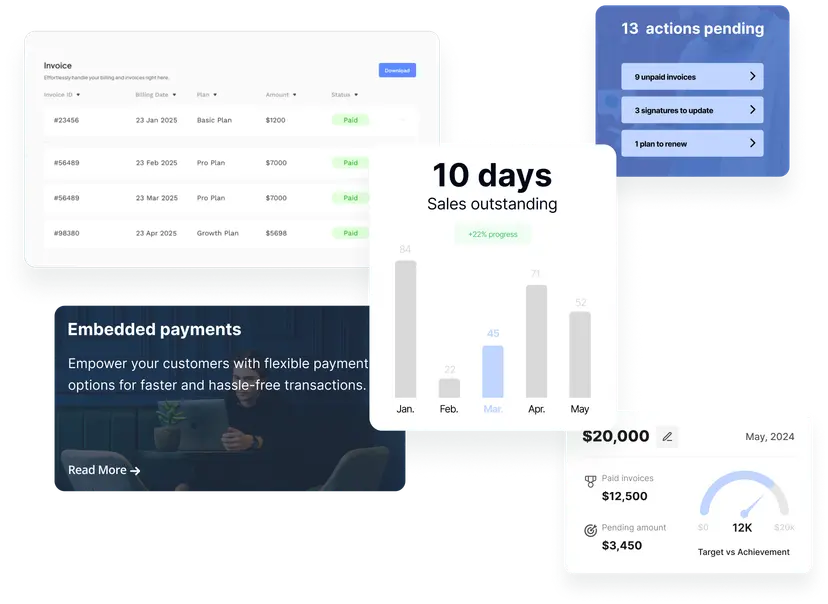How Cash Flow Optimization help a CFO’s
Cash flow optimization ensures businesses maintain healthy liquidity by accelerating receivables, delaying payables strategically, and leveraging automation. Financial managers use tools like UPFRONT to forecast cash gaps and improve working capital efficiency.
What is Cash Flow Optimization?
Cash flow optimization is the process of enhancing a business’s cash flow by improving inflows, controlling outflows, and aligning the timing of cash movements. This ensures that a company maintains sufficient liquidity to cover operational expenses, meet financial commitments, and invest in growth initiatives.
For finance teams, cash flow management in financial planning is not just about keeping the lights on—it’s a strategic approach to securing financial health, reducing risks, and seizing market opportunities with confidence.
What is the Purpose of Cash Flow Optimization?
The primary purpose of cash flow optimization is to ensure that an organization has enough working capital to operate efficiently and scale sustainably. It helps finance teams carefully monitor operating, investing, and financing activities to uncover ways to improve liquidity.
When well-executed, cash flow optimization supports:
- Strong liquidity management
- Smarter capital allocation
- Reduced reliance on short-term financing
- Strategic investment in growth opportunities
This proactive approach reflects the importance of cash flow forecasting for SMEs , allowing businesses to anticipate future funding needs and avoid cash shortfalls that can restrict operations or damage supplier relationships.
Why is Cash Flow Optimization Important?
In today’s fast-paced financial environment, where market dynamics shift rapidly, cash flow optimisation challenges have become a core function of finance teams. Here’s why it matters:
1. Financial Stability
By prioritizing cash flow optimization strategies, companies can maintain consistent liquidity to cover payroll, supplier payments, and operational costs—ensuring long-term stability even during market disruptions.
2. Improved Decision-Making
The role of the cash flow statement in business decision-making is crucial. A clear view of cash inflows and outflows helps finance leaders decide when to invest, expand, or secure financing. This clarity reduces the risk of ill-timed or over-leveraged growth moves.
3. Enhanced Planning and Forecasting
For SMEs, the importance of cash flow forecasting cannot be overstated. Predicting future cash positions based on historical trends and market expectations allows for proactive decision-making, preventing last-minute cash crises.
4. Better Supplier and Lender Relations
On-time payments and predictable cash flow build trust with suppliers and lenders, resulting in favorable credit terms and lower financing costs.
5. Increased Profitability
A fine-tuned cash flow system minimizes unnecessary costs, unlocks working capital, and maximizes ROI on operational expenses—boosting overall profitability.
6. Reduced Debt Dependency
Healthy cash flow lowers reliance on external borrowing, cutting interest expenses and improving balance sheet strength.
7. Understanding Cash Flow vs. Profit in Financial Management
Many businesses confuse profit with cash availability. While profit reflects accounting earnings, cash flow vs. profit in financial management highlights that profit on paper doesn’t guarantee liquidity. Optimization ensures actual cash is available to sustain daily operations.
Examples of Cash Flow Optimization Strategies for Finance Teams
Cash flow optimization for financial manager example, Top-performing finance teams apply a mix of these practical cash flow optimisation strategies to improve liquidity:
- Automating Accounts Receivable : Leveraging AR automation tools like UPFRONT helps accelerate collections, reduce DSO, and improve predictability.
- Inventory Optimization : Holding only necessary inventory levels frees up cash without affecting sales or customer service.
- Cost Control : Identifying and cutting non-essential expenses boosts available cash for high-priority initiatives.
- Debt Restructuring : Refinancing high-interest debt reduces interest burdens and improves cash flow.
- Automated Cash Positioning and Reconciliation : Tools such as HighRadius’ cash management solutions automate daily cash positioning and reduce reconciliation delays, giving finance leaders real-time visibility.
Cash Flow Optimization Challenges
Despite its importance, cash flow optimization poses several challenges:
- Inaccurate Forecasting : Without reliable data and assumptions, cash flow forecasting models can mislead decision-making.
- Poor Working Capital Management : Mismanaged receivables, payables, or inventory tie up cash unnecessarily.
- Manual Processes : Lack of automation in invoicing, payments, and collections delays cash inflows.
- Limited Access to Capital : For SMEs, insufficient funding options can hinder liquidity flexibility.
- External Risks : Market downturns, inflation, and supply chain disruptions can unpredictably affect cash flow.
- Cash Reserve Management : Striking a balance between holding sufficient cash reserves and investing for growth remains a complex decision for finance teams.
Why Cash Flow Optimization is a CFO’s Top Priority
According to a U.S. Bank study, 72% of businesses fail due to cash flow problems —not profitability. For finance teams operating in the GCC region, this risk is amplified by:
- Late customer payments (46% of UAE invoices are delayed)
- Manual cash processes that introduce human error
- Limited visibility into future cash positions (34% of businesses can’t accurately predict 90-day liquidity)
This makes cash flow management in financial planning a core responsibility for every CFO.
Key Benefits for CFOs:
- Avoid Liquidity Crunches : Maintain sufficient cash even during seasonal revenue dips or delayed payments—despite showing profitability on paper (a classic example of the difference between cash flow vs profit in financial management ).
- Capture Growth Opportunities : Quickly fund expansion projects, bulk inventory purchases, or market entry plans without costly financing.
- Reduce Borrowing Costs : With accurate cash flow forecasting, reliance on expensive credit lines or emergency loans is minimized.
- Meet VAT and Payroll Deadlines : Compliance with GCC tax regulations and timely payroll disbursement protects against fines and reputational risk.
Struggling with Cash Flow Gaps?
UPFRONT’s AI-powered platform gives you 90-day cash visibility and automates 85% of cash management tasks. Take control today.
Book a Free Cash Flow Audit →Cash Flow Metrics Every Financial Manager Should Track
| Metric | Formula | Healthy Benchmark |
|---|---|---|
| Operating Cash Flow Ratio | Operating Cash Flow / Current Liabilities | >1.0 |
| Days Sales Outstanding (DSO) | (Accounts Receivable / Total Credit Sales) x Days | <45 days |
| Cash Conversion Cycle | DIO + DSO – DPO | Negative = Ideal |
| Burn Rate | Monthly Cash Outflows | <6 months runway |
Pro Tip: UPFRONT auto-calculates these metrics in real-time with drill-down capabilities.
FAQs: Cash Flow Challenges in the UAE
1. What is the most important factor in successfully managing your cash flow?
The most critical factor in managing cash flow successfully is accurate cash flow forecasting . Without reliable forecasts, businesses risk liquidity shortages even when profitable on paper. By predicting inflows (such as receivables) and outflows (like payables, VAT obligations, payroll), finance teams can adjust operations, delay expenses, or secure funding proactively.
Platforms like UPFRONT help CFOs and financial controllers improve cash visibility by automating forecasting and identifying potential cash gaps 60+ days in advance.
2. Why is cash flow important to financial managers?
For financial managers, cash flow is the foundation of operational and strategic decision-making . While profits indicate overall business health, cash flow reflects real-time liquidity—ensuring that the company can meet obligations, fund investments, and survive market fluctuations.
In regions like the UAE and GCC, where payment delays and regulatory deadlines (such as VAT filings) are common, cash flow optimization is essential to prevent disruptions and avoid costly borrowing.
3. How to manage your business cash flow effectively and efficiently?
To manage cash flow effectively, finance teams should implement the following cash flow optimization strategies :
- Automate Accounts Receivable : Speed up collections using e-invoicing and payment reminders.
- Optimize Payables Timing : Align supplier payments with the cash conversion cycle to avoid early or late fees.
- Improve Forecasting Accuracy : Use AI-driven tools like UPFRONT for real-time, scenario-based cash flow predictions.
- Control Operating Expenses : Regularly review and reduce unnecessary overheads.
- Leverage Financing Wisely : Utilize short-term financing options like factoring when necessary to cover cash gaps.
These steps ensure smooth cash flow management in financial planning , supporting both daily operations and long-term growth.
4. Are financial managers responsible for controlling cash flows?
Yes— controlling cash flows is a core responsibility of financial managers and CFOs . Their role includes monitoring all cash inflows and outflows, maintaining liquidity, ensuring compliance with tax and payroll obligations, and preparing for unexpected financial needs.
Effective cash flow control directly impacts profitability, risk management, and investment potential, making it a top priority for finance leaders aiming to improve their organization’s working capital efficiency.
→ Growth blueprint: Strategic Financial Decisions → Cycle acceleration: Improve Cash Conversion → Capital strategy: Investment Strategies → Risk shield: Risk Management Strategies → Liquidity engineering: Cash Flow Optimization





